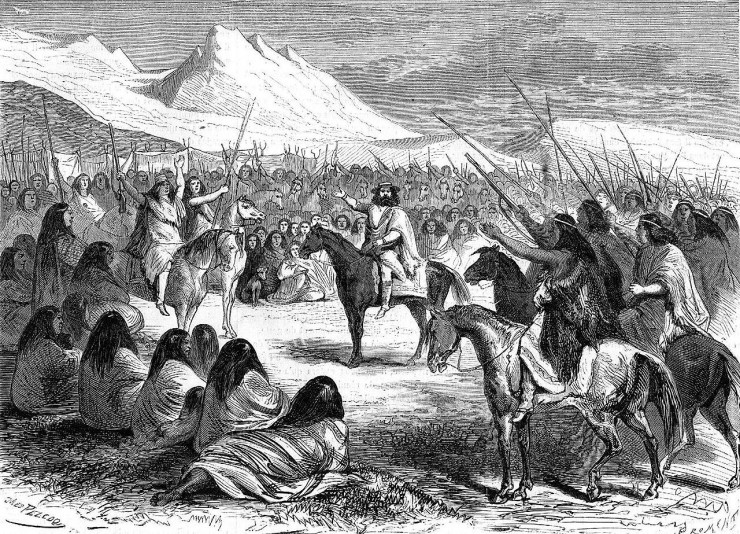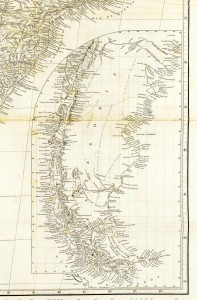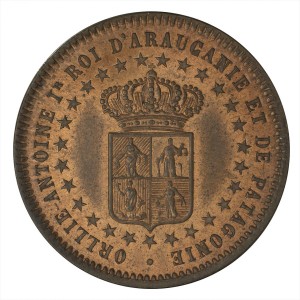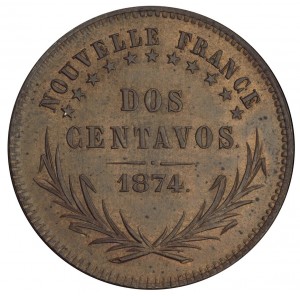Coins from a nation that wasn’t: Araucania and Patagonia
By David Bergeron, Curator
D’Antoine de Tounens in a meeting with the Mapuche people of Patagonia. (Wikimedia Commons, Jules Peco?)
It is not unusual for “micro-nations”— city-states, principalities or minor kingdoms—to produce their own currency. Having a national currency is one way that a fledgling nation can promote its independence—sometimes before there even is a nation. But this coin, from a purely conceptual country in South America, is most intriguing for the history it now represents: the attempt of an indigenous people to establish their own nation in the face of colonization. Even more intriguing, what’s stamped on the coin implies this imaginary nation had already been colonized–by France.
Patagonia from the survey by the British ships Adventure and Beagle. (Wikimedia Commons, John Arrowsmith, 1842)
In the middle of the 19th century, a French lawyer and adventurer named d’Antoine de Tounens became fascinated by the Mapuche people of the Patagonia region of South America. The Mapuche were struggling to protect their ancestral lands, their identity and their culture from colonial expansion by the governments of Chile and Argentina. De Tounens went to Chile in 1858 to meet the Mapuche, whom he admired for what he regarded as their heroic resistance, and took up their campaign for self‑determination and sovereignty. In co-operation with their leaders, de Tounens drafted a constitution for “Araucania and Patagonia”, a region located in the southern half of modern Chile and Argentina. They declared the district a kingdom and de Tounens was named as its first monarch. The Chilean government arrested him in 1862, put him on trial and declared him insane. Narrowly avoiding execution, de Tounens was deported to France.
The National Currency Collection possesses three 2-centavo coins minted for Araucania and Patagonia in 1874. What is so curious about these coins is that they claim this potential nation for France. The legend on the reverse reads “NOUVELLE FRANCE / DOS / CENTAVOS / 1874". De Tounens appeared to have baptized the nation as part of New France, yet this designation is seen nowhere else but on the coins. The coins don’t originate from South America but by some accounts may have been struck, presumably at de Tounens’ request, in Belgium.
De Tounens intended to take the coins back with him to Patagonia to help re-establish his kingdom. Although he returned and failed on several occasions, a number of countries did choose to recognize his fledgling state. But it was not to be. In 1878, Orélie-Antoine de Tounens (as his magisterial name was) died in France as the exiled King of Araucania and Patagonia. A successor to the office of Royal Highness to the Crown of Araucania and Patagonia (in exile) still lives in France today–Prince Antoine IV.
The Museum Blog
A Curator’s Favourite Task
By: David Bergeron
I have several key responsibilities to meet the requirements of my job. None of them is more gratifying than conducting research about the incredible artifacts in the Bank’s collection.
How’re We Doing So Far?
By: Graham Iddon
It’s all good, and we couldn’t be happier with our first few weeks of business.
Unpacking the Collection 6
By: David Bergeron
In 1934 the Department of Finance invited Emanuel Hahn to submit a design for a silver dollar to commemorate the Silver Jubilee of King George V’s reign.
Our Grand Opening…
By: Graham Iddon
After four years of plans, worries, setbacks, successes and sheer hard work, the Bank of Canada Museum opened its doors—on Canada Day, right on schedule.
Museum Reconstruction - Part 8
By: Graham Iddon
The last few stragglers among our artifacts are ready for installation and the interactives and digital labels are bulking up with the final software and data, in them, so it’s all there, functional and looking fantastic.
The Yap Stone Returns
By: Graham Iddon
For us, its removal from the Garden Court dramatically marked the Currency Museum’s closing. The big stone’s return now performs the opposite role for the new Bank of Canada Museum—heralding its opening.
A New Ten on the Block
By: Graham Iddon
In a modern twist, Governor Stephen S. Poloz took a “selfie” while holding a C150 note before meeting up with the Honourable Ginette Petipas Taylor for the main photo op.









